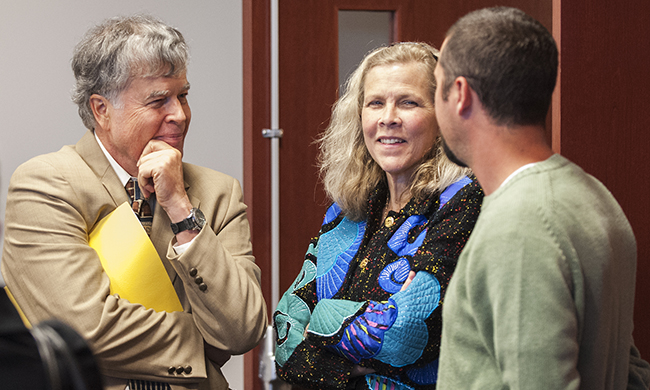CSD professor awarded rare second Fulbright
Gray headed to India for cancer research
Health and BehaviorSUMMARY: While it is impressive for an academic to be awarded a Fulbright Scholarship once in a career, it is a rare feat when they are awarded a second. This was recently accomplished by Communication Sciences and Disorders (CSD) professor Dr. Lincoln Gray, who will be traveling to Mumbai this winter break and next summer to continue his research on oral and breast cancer metastases.
By: Daniel Vieth '15, '17
Creative Services

Since 1946, the Department of State’s Fulbright Scholarship Program has awarded approximately 8,000 grants a year, providing scholars the opportunity to teach and research in one of over 140 countries. While it is impressive for an academic to be awarded a Fulbright Scholarship once in a career, it is a rare feat when they are awarded a second. This was recently accomplished by Communication Sciences and Disorders (CSD) professor Dr. Lincoln Gray, who will be traveling to Mumbai this winter break and next summer to continue his research on oral and breast cancer metastases.
Gray originally traveled to Mumbai as an undergraduate student, later returning in 1997 for Fulbright’s North Africa/South Asia Regional Research Program. Most recently, Gray spent a brief time in the city to prepare for his upcoming Fulbright research. “Coming back to Mumbai feels like the circle of life,” said Gray. “I am grateful to my dean [Dr. Sharon Lovell] and JMU’s Office of International Programs for funding my trip. It gave me a chance to reconnect with people I had worked with before, make sure I could handle the city in the monsoon season, and get an official invitation to perform the research, which is critical for the Fulbright.”
When he returns to Mumbai in December, Gray will be researching at the Tata Memorial Centre, a hospital in Mumbai that sees more oral cancers than anywhere in the world. “Cancers as a whole are relatively rare in South Asia, basically due to calorie restrictions,” said Gray. “In general, if you don’t eat as much, you are far less likely to get cancer.” In contrast, India’s population is disproportionately impacted by oral cancers, due in part to the high smoking rates and to the common practice of chewing betel nut, or paan. “Paan is a carcinogenic nut that many people will chew throughout the day,” said Gray. “You’ll see somebody selling paan on every half a block, and they serve it at the end of meals; chewing it is a part of their culture.”
Gray has been collecting data from places like England, France, Sweden, New Zealand, Egypt, Pakistan, and India on how cancers metastasize, or spread to different parts of the body. For example, while some cancers like skin cancer typically spread to the nearest physical location on the body, others like oral and breast are more dangerous as they often travel to what appear to be random parts of the body. According to Gray’s research, however, the spread is not random and can be predicted through data analysis. “So what I do is go around the world collecting data on the extent to which there are tumors in one place that tend to spread to another place, then use a mathematical technique called ‘multidimensional scaling’ to construct maps of how these cancers metastasize,” Gray explained. “These maps don’t measure physical distance as we see it, but rather view our body as “seen” by the tumor. In other words, I am mapping the ‘phenotype’ or behavior of the cancer.”
In addition, the research has shown subtle differences in how the diseases metastasize in different parts of the world, possibly due to the etiology, or cause, of the cancers. While oral cancers are more often caused by tobacco in America and Europe, the etiology may be more strongly linked to chewing paan in India. “These maps that I make are different in the Eastern and Western Hemisphere, which is important to understand for surgeons in India who were trained in the US or UK, or read medical textbooks from the US and UK,” Gray continued. “The patterns they learned are slightly, but significantly different statistically speaking from what they will see in the patients they are working with, which is important for them to recognize.”
Gray will be traveling to Mumbai with his wife, a brain-injury specialist. “I do hope that I can make a modest contribution to the really gnarly problem of cancer worldwide,” Gray continued. “I am also looking forward to coming back to Mumbai. It’s not exactly an easy place to live, but it is one of the great cities of the world.”

